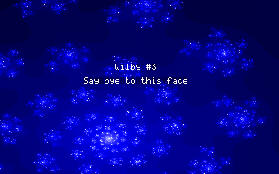
Wilby, successfully resisting the zeitgeist?
The first to come with the idea was Hugi. And then, all of a sudden every international diskmag had it. What am I talking about? Non-fixed width fonts. In the Hugi #16 editorial, I suggested implementing non-fixed width fonts in our next diskmag engine. That was in July 1999. Three months later, Pain 10/99 was released. What new feature did it have, among others? Correct. Support for non-fixed width fonts. Same goes for shineRETRO released one and a half months later.
Non-fixed width font support is one of the latest fashions of PC diskmags. Another is a Win32 interface (which Hugi has had since August 1998). Or clipart support (also an old feature of Hugi's). Or multiple background graphics support. Diskmag engines are getting more technically advanced. They make mags bigger and more CPU-consuming, but better looking and a greater pleasure to read. It has been time.
But, surprise, there is a newly founded diskmag that runs counter all these trends: Wilby by Spock of Wild Bits. The first issue, released at the end of September, is subtitled "The smallest diskmag ever" - and it is the smallest diskmag that has ever been released: All code, graphics and texts occupy just 4095 bytes. That's even smaller than Beam #3, which had a size of 6 kbyte. Wilby #1 has created a new genre of scene productions: the 4k diskmag!
Wilby is an icon of self-imposed minimalism. While other diskmags strive for having as many and as long articles as possible, it's just the contrary with Wilby. The maximum size of an article is 16x51 characters, plus the title and the name of the author. That makes just 816 bytes, not even one kbyte per article! How can you write such short articles and still make them interesting, entertaining and informative? That is the very challenge! The writer is forced to compress his text so that the reader is still able to follow his argumentation despite the limited text-grid he has at his disposal.

Some writers have well managed to write comparably good articles in spite of this limit. For example, Seven has written several articles that demonstrate tricks how you can size optimize your Assembler code. And Makke's 800-byte ramblings about his military service and the popularity of inactive sceners are also quite fun to read. Of course article-size optimizing is an art like code-size optimizing, and the more experience you get with it, the better your results will be.
The same as for the articles goes for the polls. Every issue of Wilby contains two short questions in its support sheets. One asks the reader about his opinion on the Wilby mag, the other deals with the scene and is varied in every issue. Instead of writing a lot of text, all you have to do is either tag a sad smiley, a neutral smiley or a laughing smiley. The next issue contains the number of people who selected the individual smileys. A picture says more than a thousand words.
And there are even charts. Following a very interesting concept. There are two categories, sceners and demogroups. But you are not asked for the "best sceners" or the "best demogroups". Neither for the "top sceners" or "top demogroups". No, not even for your "favourites". You are asked for the "most popular sceners" and the "most popular demogroups". Now I hear the sticklers complain: "But how should I know who the most popular sceners and the most popular demogroups are? And among what group of people?" Let's not care about the sticklers. I think it is an interesting idea to ask for the most popular people instead of one's favourites. It's fun thinking about who the most popular scener might be when filling in the Wilby votesheet.
So far three issues of Wilby have been released. Each of them was a tad bigger than its predecessor, but only a TAD. All issues have been around 5 kbytes of size and the text amount around about 8 kbytes (the texts are compressed, of course).
Now Spock announced in Wilby issue 3 that the next issue would come along with a new engine and be considerably larger than usual. Has the last diskmag that resisted the zeitgeist finally been defeated by the times of time? Will Wilby become just another normal disk magazine? Or is it rather that Spock has a new creative idea that will surprise us all again? Future will give answers to these questions.
You can get Wilby at Spock's website and via the Wilby distribution mailinglist.